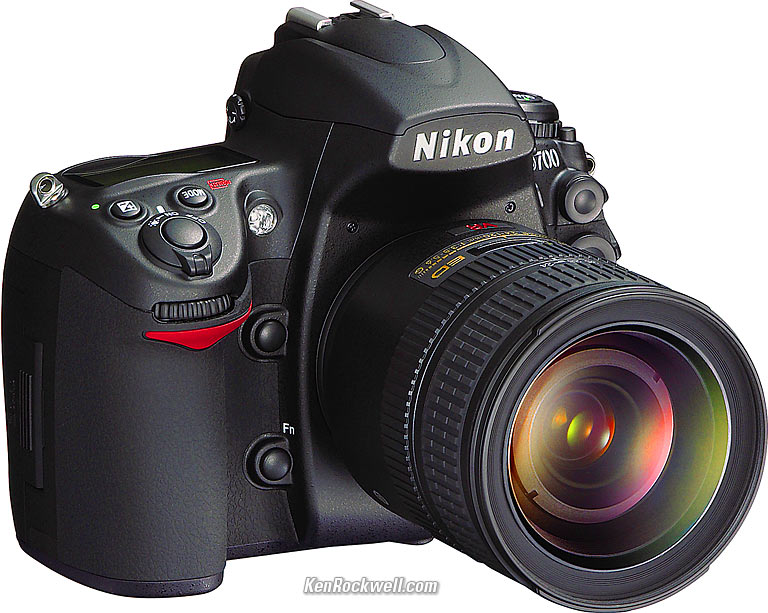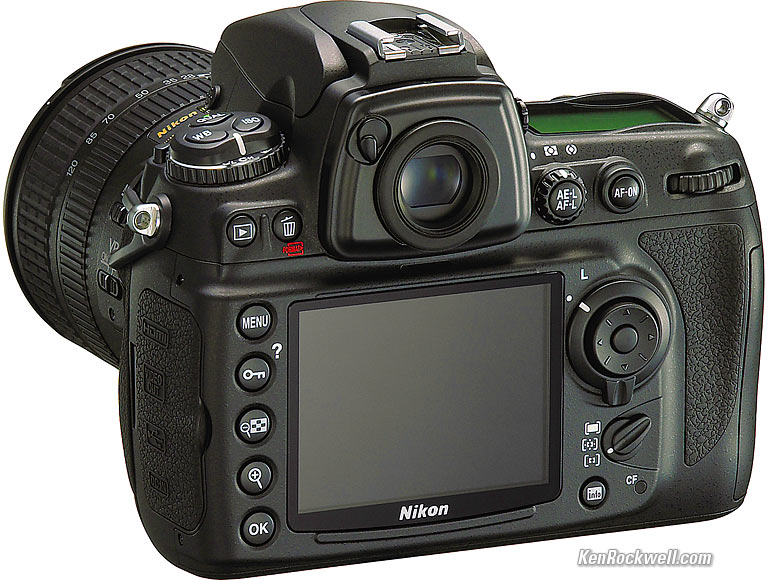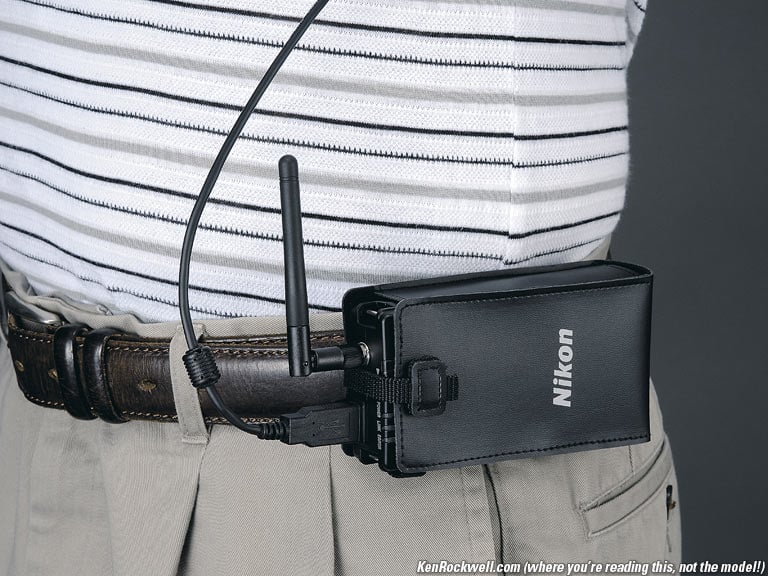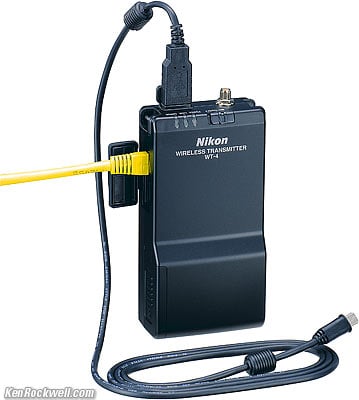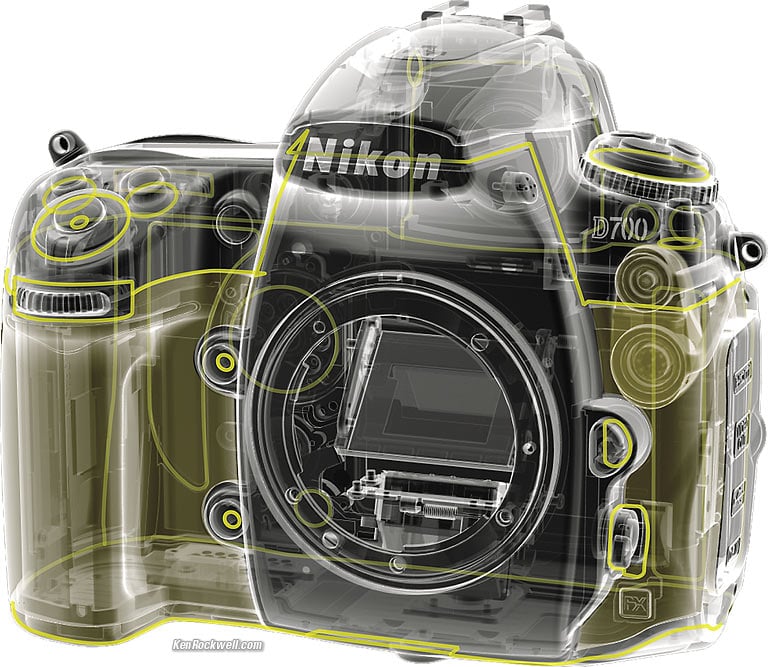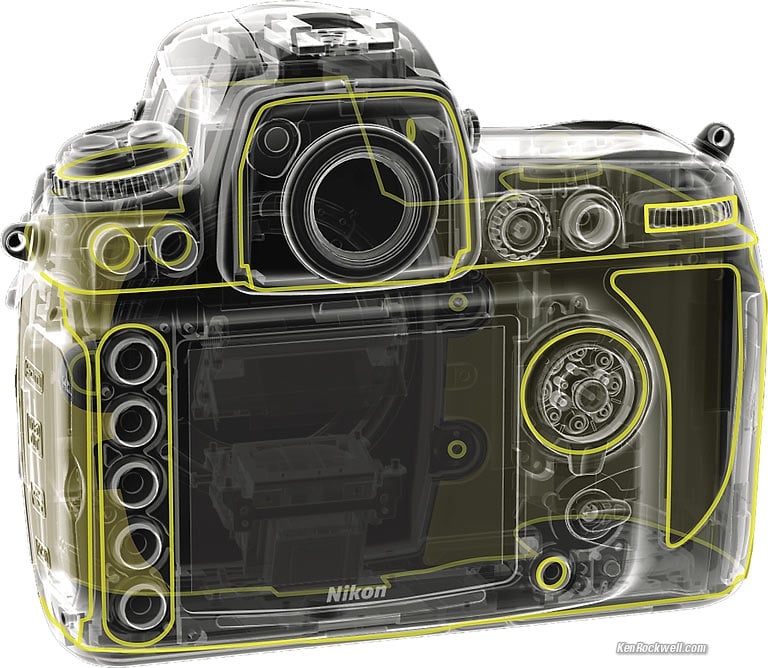Total Information of Nikon D700 in India
Nikon D700 with 24-120mm VR. enlarge.
Nikon D700. enlarge.
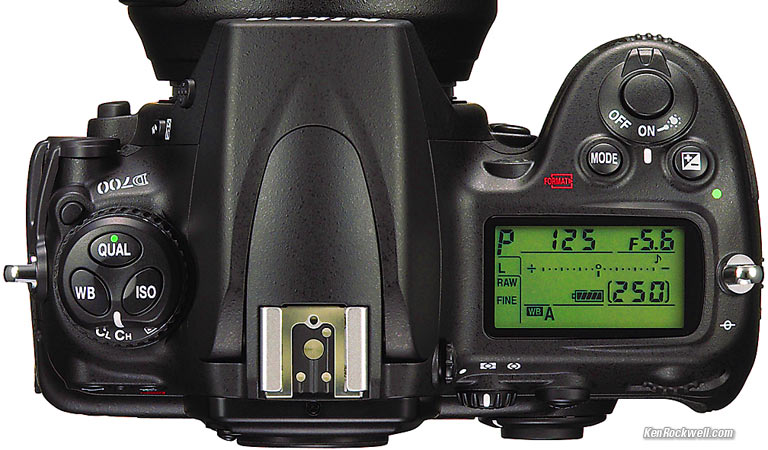
The Nikon D700 is Nikon's top new amateur camera. It's mostly a D300 with the larger FX sensor of the D3, and priced directly between the two. Thus it has image quality mostly identical to the D3, but D300-class handling, which is a notch or two below the D3 for sports and action.
The Nikon D700 adds a cleaning system and a separate new rear INFO button. Beyond that' I'm not seeing anything life-changing that isn't already in the D3 and D300.
The function button can be assigned to do more more things, probably including the Picture Control option, but if you do, you lose what you could have programmed the FUNC button instead. I already have to swap my FUNC button among FX/DX digital zoom, non-CPU lens swapping or virtual horizon.
Don't get too excited; the D3 is no sharper than the D300. The only reason to love the FX sensor over the DX sensor of the D300 is for much cleaner images at high ISOs and for ultra-ultra-wide shots. For ultra-ultra wide shots, you'll also need to buy a 14-24mm, 14mm f/2.8 AF-D or 15mm f/3.5 lens, each over $1,000.
For sports and action, the D3 is still king. I don't see that the D700 is any faster than the D300.
Then again, the D700 has a built-in flash and remote wireless flash controller. Honestly, with the D3 and therefore the D700, you just don't need flash anymore except for fill.
One very compelling reason to get this D700 over the D300 is the huge viewfinder. For many people, this could be worth the extra $1,200 alone. The D700's finder is bigger, brighter and sharper than any Nikon digital camera other than the D3. This isn't obvious until you pick it up. The huge difference is because the finder covers the larger FX frame, not just the puny DX frame. When you compare coverage and magnification specifications, remember that each spec is referenced to the format covered, and FX covers 150% of the DX frame!
Lens Compatibility
Thank goodness, the D700 works with all conventional AF, AF-D and AF-S lenses. Every Nikon AF lens ever made since
It also meters with AI and AI-s manual focus lenses as does the D3, and if you enter the focal length and f/stop, gives matrix metering, aperture-priority and manual exposure and correct EXIF data. Whoo hoo, this means you can use the full catalog of manual lenses.
DX lenses work on the D700, but who cares? THe D700 is only a 5MP camera with a DX lens, because it only uses the middle of the sensor. It's silly to use DX lenses on the D700; even the D40 has more resolotion (6MP) with DX lenses than either the D700 or D3.
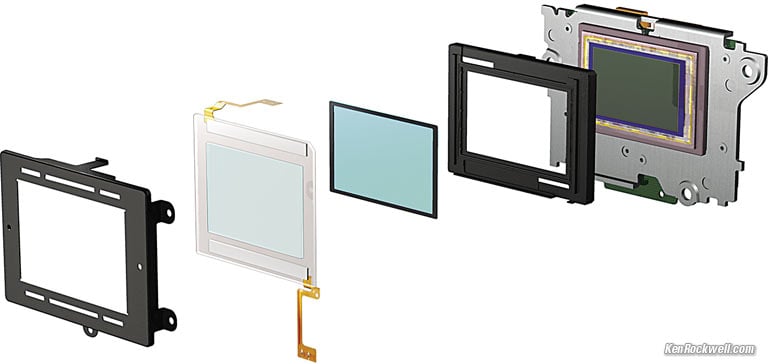
FX sensor and cleaning apparatus.
Finder: 18mm eyepoint. 95% coverage, 0.72x with 50mm lens. (D3 is 0.7x and 100% coverage.) Inferior finder in DX, doesn't crop the finder as does D3.
Electronic Level: Yes, electronic virtual horizon, just like D3.
AF: 51 points. CAM3500FX sensor array (same as D3 and D300). Fine-tuning, if you have slight errors with certain lenses.
Shutter: 1/8,000 ~ 30 sec, bulb. Carbon fiber and kevlar, tested to 150,000 cycles.
Flash Sync: 1/250.
Frame Rate: 5 FPS. 8 FPS with MB-D10 and EN-EL4 or 8-AA battery.
Built-in Flash: GN 39/12 (Feet/meters at ISO 100). Controls wireless flash.
Sensor: 12.1MP CMOS, same as D3. 14-bit linear ADC, 16-bit data pipelines, as the D3. 12-channel parallel readout.
Sensor Size: FX (23.9 x 36mm) and cropped DX, just like D3. No professional 5:4 mode.
Live View: two modes.
Resolution: 12.1MP in FX, 5MP in DX.
FX: 4,256 x 2,832 (L), 3,184 x 2,120 (M), 2,128 x 1,416 (S).
DX: 2,784 x 1,848 (L), 2,080 x 1,384 (M), 1,392 x 920 (S)
ISO: 200~6,400, from ISO 100 up to 25,600 in push and pull modes.
File Formats: JPG, TIF, NEF. NEF in 12- or 14-bit with no, lossy or lossless compression.
Rear LCD: 3," 920,000 pixels. HDMI HD output.
Storage: Single CF card. Too bad; I love the in-camera backup of the D3's dual card slots.
Data Communication: USB. Optional WT-4 wireless and ethernet.
Optional Macho-Man Grip: MB-D10.
Power: EN-EL3e, standard; same as D200, D300, etc.
Size: 5.8 x 4.8 x 3.0" (147 x 123 x 77mm).
Weight: 35.1 oz. (995g) without battery, card, strap, monitor cover or lens.
Price: $2,999.95. Do you think Nikon is going to give you FX for free over the price of a D300?
Introduction: 01 July 2008.
Available: Late July 2008.
Rechargeable Li-ion Battery EN-EL3e
Quick Charger MH-18a
USB Cable UC-E4
Video Cable EG-D100
Camera Strap AN-D700
Body Cap BF-1A
Accessory Shoe Cover BS-1
LCD Monitor Cover BM-9
Software CD
Optional Accessories
MB-D10 grip (same as D300)
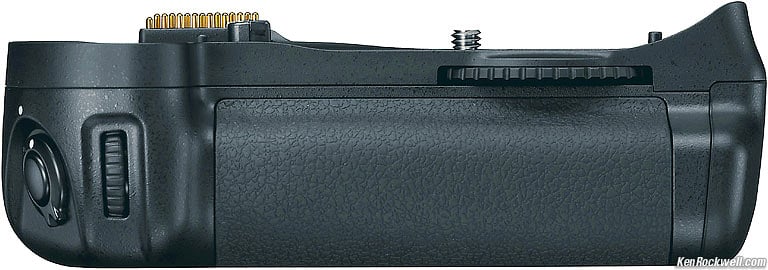
MB-D10 grip, front.
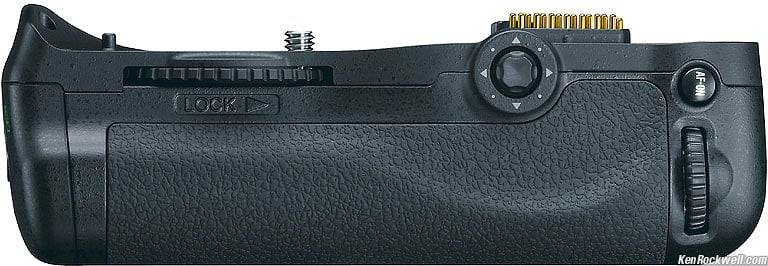
MB-D10 grip, rear.
The $240 MB-D10 grip uses one EN-EL4a/4/3e rechargeable Li-ion battery, or eight AA batteries.
It has a shutter-release, AF-ON button, multi selector, and main- and sub-command dials.
Using EN-EL4a/4 or eight AA-size batteries, it can shoot at full resolution at 8 fps. So what' the D300 does the same thing and isn't anywhere as fast as the D3.
WT-4/4A Wireless Transmitter
Nikon WT-4 Transmitter
The $700 WT-4/4A provides ethernet (10BASE-T, 100BASE-TX) and WiFi (802.11b/g, 11a) data connections to the D700, D300 and D3.
It looks like something out of the 1970s — it's another piece of junk with a wire to haul around; it isn't integrated in the camera. If you want to connect via ethernet, you plug your ethernet cable into this thing, while its plugged into the camera. Geesh!
WT-4 for ethernet: camera on one cable and computer on the other not shown!
A PC allows wireless connection of up to five cameras, for display of thumbnail images and downloading of selected images. Using optional Camera Control Pro 2 software (probably as buggy as all the other Nikon software) and the Live View function, you can shoot and view remotely.
EH-5a/EH-5 AC Adapter
DK-17M Magnifying Eyepiece
Optional Software: Image Authentication, Capture NX 2 and Camera Control Pro 2 software.
D700 X-ray view. Green spaghetti are dust seals. enlarge.
Another D700 X-ray spaghetti-gram, from the rear.
I expect the speed and dynamics to match the D300. Battery life ought to be a bit less than the D300.
I expect the technical image quality to match the D3, which is excellent, but still not as sharp as a Canon 5D which you can buy today for $1,900 brand new.
Even today, the colors, dynamic range and sharpness of the D300 matches the D3. The only thing that changes with the fatter FX D3 sensor is lower noise and the potential to shoot ultra-ultra wide lenses.
Nikon claims the same start-up and shutter lag times as the D3 (120ms and 40ms, respectively), but that's not what makes the D3 so fast.
What the D700 does better than the D300
Bigger, better finder! Eyepiece blind. For many people, the better finder could justify the cost over the D300.
The rear INFO button is now its own button, so it won't interact with the file lock button of the D300 and D3. THis is actually an important improvement, but not as important as adding a Picture Control Select button, which is still missing.
Wider ultra-wide lenses available. the 12-24mm DX is realty only equivalent to a 20mm lens on the D700. WIth a 14-24mm, or even a manual-focus 18mm, the D700 is wider than any Nikon lens on any DX camera.
Much better in low light, and even in bright, contrasty light. THe D300 has noise issues even at ISO 200 with ADR on. You could shoot the D700 above ISO 6,400 and get great results, but you won't have to. ISO 6,400 is way fast enough, presuming you've got fast lenses like the 50mm f/1.4 AF-D.
What the D700 does better than the D3
$2,000 less expensive.
Smaller and lighter, unless you opt for the grip.
Sensor cleaner.
What the D3 still does better than the D700
Faster! Not only is the frame rate much faster, the D3 is way faster than the D300 because it has bigger motors, bigger AF-S drivers and more processing horsepower to do all the math required of the AF system. I suspect the D3 will similarly be faster than the D700.
5:4 crop mode (not in D700). I use this daily!
D3 has onboard live backup with a second card slot, which I use all the time. D700, as an amateur camera, only has one slot.
No sensor cleaner working every time you turn it on means the D3 probably fires up faster than the D700.
Bigger battery, unless you add the grip to the D700.
D3 has a rear data LCD, which I've not found that useful. D700 has none.
Shutter "tested" to 300,000 cycles, vs. 150,000.
Better finder for DX; the D3 crops well instead of just drawing a rectangle.
D3 may have far superior finder if the D700 has the same silly obstructive-black active AF area indicators. (The D3 has unconstructively lit active AF areas.)
The D700 has no card-door release lever, since the new INFO button is there. I suspect the D700 card door will feel worthless and weak, like the doors on my Canon DSLRs.
The D700 is an amateur camera. By default, the D700 has the idiot beeper (CFN d1) ON, while the professional D3 has it OFF.
The D3 is tougher.
The D3 has a super easy-to-use note-taking function: just press the mic button
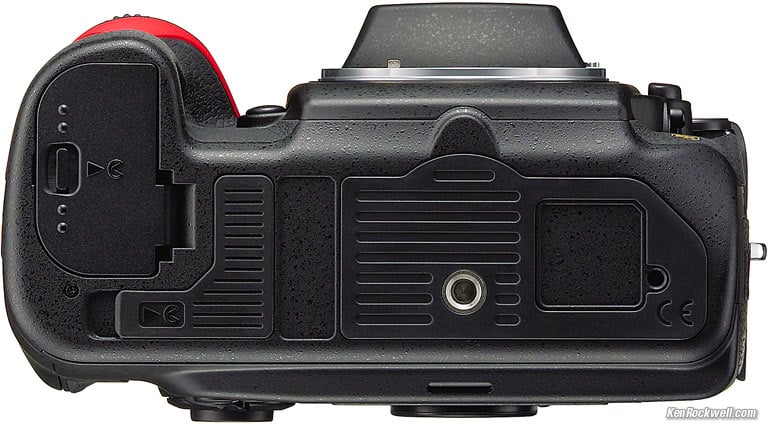
The only thing you're getting for $1,200 more than a D300 is much better finder, much better high-ISO performance and a green light to buy even more expensive ultra-ultra wide lenses. For most people, I wouldn't bother, or I'd step up all the way to the much faster and fully professional D3.
If you're shooting sports and action, the D3 is still your camera. If you're shooting landscapes, the D3X (not yet public) or Canon 5D is better.
Honest: if I need landscape image quality, the Canon 5D beats the D3 and costs and weighs much less. If I want speed for sports, action and news, the D3 has far faster AF and frame rates than any of these. The D700 or D3 aren't the cameras for landscapes; that's the 5D or D3X.
The introduction of Nikon's new D700 may been one of the worst kept secrets in an industry with more leaks than the Titanic, but it was still something of a surprise coming so hot on the heels of the D3 and D300. Essentially a D3 shrunk down and squeezed into a body roughly the same size as a D300, the D700 is Nikon's first 'compact' professional SLR, and seems designed to go head-to-head with whatever Canon has up its inscrutable sleeve to replace the EOS 5D.
The imaging side of the D700 is pretty much the same as the D3; it shares the acclaimed 12.1MP full frame ('FX') sensor and has the same processing engine, so we would presume output to be almost identical. The main differences (aside from being considerably smaller) are physical; there's a different shutter (good for 150,000 exposures rather than 300,000 on the D3), different viewfinder prism (with 95% coverage) and a slower burst rate. You also lose the rear LCD info panel (there's no room for it) and one of the D3's two CF card slots, but you do get a couple of extra features to soften the blow slightly; most notably a self-cleaning sensor and a built-in flash. We'll look a little more in-depth at the differences between the D3 and D700 in a moment.
The D700 joins the D3 as a fully-fledged 'professional' model; it has the same tank-like build quality (though we're sure the pop-up flash will cause a few raised eyebrows), and gets you the full pro service from Nikon. And the pricing (around $2999) reflects this; anyone hoping for an 'affordable' semi-pro full frame Nikon SLR will have to wait until the cost of producing such large sensors falls considerably.
Nikon D700 Key Features
- 12.1 megapixel full-frame sensor (8.45µm pixel pitch)
- Image Sensor Cleaning (vibration) *
- ISO 200 - 6400 (with boost up to ISO 25600 and down to ISO 100)
- Also supports DX lenses, viewfinder automatically masks (5.1 megapixels with DX lens)
- 14-bit A/D conversion, 12 channel readout
- Same ultra-fast startup and shutter lag as D3
- Nikon EXPEED image processor (Capture NX processing and NR algorithms, lower power)
- New Kevlar / carbon fibre composite shutter with 150,000 exposure durability *
- Multi-CAM3500FX Auto Focus sensor (51-point, 15 cross-type, more vertical coverage)
- Auto-focus tracking by color (using information from 1005-pixel AE sensor)
- 95% coverage, 0.72x magnification viewfinder *
- Auto-focus calibration (fine-tuning), fixed body or up to 20 separate lens settings
- Scene Recognition System (uses AE sensor, AF sensor)
- Picture Control image parameter presets
- 5 frames per second continuous with auto-focus tracking*
- Optional MB-D10 Battery Pack (same as D300), increases burst rate to 8 fps *
- UDMA compatible single CF card slot *
- 3.0" 922,000 pixel LCD monitor
- Live View with either phase detect (mirror up/down) or contrast detect Auto Focus
- Virtual horizon indicates if camera is level (like an aircraft cockpit display)
- HDMI HD video output
- 'Active D-Lighting' (adjusts metering as well as applying D-Lighting curve)
- Detailed 'Control Panel' type display on LCD monitor, changes color in darkness
- Magnesium alloy body with connections and buttons sealed against moisture
- Improved Info display on main screen *
* Different to D3
Nikon D700 vs D3: Key Differences
Although the D3 and D700 are essentially the same camera in a different form factor (the D700 being far closer to the D300 in design and control layout), there are a few important specification differences.

- Smaller, lighter body *
- Built-in iTTL flash (G.No 17 / ISO 200)
- No rear information panel (new info display on main LCD)
- D700 doesn't have the D3's 5:4 aspect ratio option
- 95% coverage, 0.72x viewfinder (D3: 100% / 0.7x)
- Focus screen DX mode now indicated with a rectangle rather than shaded area
- Lower burst rate (5.0 fps / 8.0 fps with optional MB-D10)
- Smaller battery (EN-EL3e)
- Optional battery grip (MB-D10, same as D300)
- Expanded Function button options (can assign any camera menu item)
- Live View can be assigned to FUNC, AE-L or Preview buttons (allowing LV + different drive modes)
- Virtual Horizon can be overlaid on Live View preview image
- Different shutter (150,000 cycle rating - same as D300)
- Image Sensor cleaning ('sensor shake' dust reduction)
- Single CF slot (D3 has two)
- Minor menu and control differences (control layout is almost identical to D300)
* D700 is approx 34mm (1.3 in) shorter, 13mm (0.5 in) narrower and 10mm (0.4 in) shallower.
Weight (no battery) : D3 - 1240g, D700 - 995gTechnology under the skin
FX format sensor (Nikon design) Sensor and sensor cleaning module RGB 1005 segment metering sensor EXPEED processor Weather sealing on the D700 body
